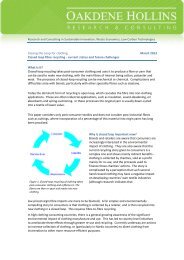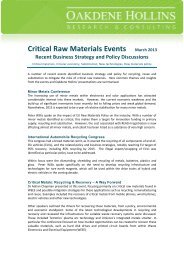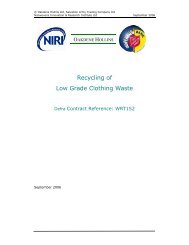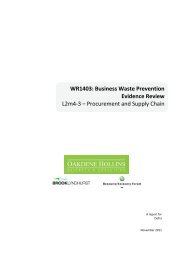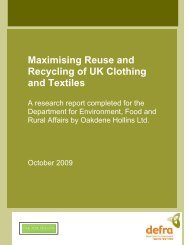Fire Retardant Technologies: safe products with ... - Oakdene Hollins
Fire Retardant Technologies: safe products with ... - Oakdene Hollins
Fire Retardant Technologies: safe products with ... - Oakdene Hollins
- No tags were found...
You also want an ePaper? Increase the reach of your titles
YUMPU automatically turns print PDFs into web optimized ePapers that Google loves.
Wool fabric of high area density, i.e. ≥ 600 g/m 2 , can pass the required fire performancetests. If a lighter wool fabric is used, it might need some fire retardant treatment (e.g. bythe ZIRPRO-treatment using hexafluoro zirconate or titanate by the exhaustion method)at nominal levels.Leather is inherently fire retardant. However, artificial leather fabrics, eg, polyurethanebased require a chemical fire retardant treatment to satisfy fire retardancy requirements.However, PVC based artificial leather will not require fire retardant treatment fordomestic furniture, but may require other fire retardant additives to pass BS5852 Crib 5or 7 tests, depending upon specific end use.9. Use a synthetic fire resistant material such as modacrylics <strong>with</strong> small amounts ofadditive FRsInherent FR fibres based on modacrylics are expensive and could restrict consumerchoice. However, some modacrylics contain small amounts of the additive FR antimonytrioxide (ATO) to enhance their fire retardancy. ATO has a risk phrase (R40) related topotential inhalation hazards but if it is incorporated and physically well bound in thematerial the risks can be significantly reduced.10. Use natural and synthetic blends to reduce cost and increase choiceBlends of different fibres can also be used, e.g. wool/modacylic, wool/nylon blends,wool/FR viscose, etc. Blends of wool <strong>with</strong> other high performance fibres like Nomex,Kevlar, Basofil, Polybenzimidazole, etc., can also be used, though the latter are veryexpensive.<strong>Fire</strong>-blockers and Interliners11. Use natural or synthetic flame resistant material or a mixture of both for fire blockersand interlinersInterliners made from inherently fire retardants fibres can further reduce the flammabilityof the product both for domestic and non-domestic applications. In general if thecovering material is made of > 75% natural fibres such as wool or an appropriate woolcontaining fibre mix, it does not need to be flame retarded to pass the Crib 5 test ofBS5852: Part 2:1989. These barrier materials can be multi-layered which allows aproduct to maintain its fire resistance even if one layer is compromised.12. Adopt transport sector fire-blocker designs in the domestic market<strong>Fire</strong>-blockers, made from inherently fire retardant fibres like oxidized acrylics andaramids, can make the product fire retardant. However, these materials are veryexpensive. <strong>Fire</strong>-blockers from oxidised acrylics and aramids are commonly used foraircraft seats; their use is increasing in trains, buses and coaches. So the adoption ofdesign practice in the transport sector could create benefits in the furniture <strong>products</strong>ector.The barrier materials can also be a blend of inexpensive natural fibres and expensivesynthetic fibres, such as Basofil, Polybenzimidazole, Kevlar, Nomex, etc. Cost may beprohibitive for general consumer markets.13. Use fibreglass wrapped in an inherently flame retarded fibre to reduce costA cheaper alternative is to use glass fibre wrapped in fabric of inherently fire retardantfibres (e.g. FR viscose) or plastic film made from neoprene, PVC which produces fireretardant species when exposed to thermal degradation conditions and to fire.P a g e 2 0 |




